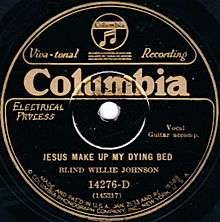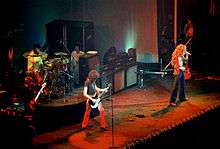In My Time of Dying
| "In My Time of Dying" | ||||
|---|---|---|---|---|
 Blind Willie Johnson 1928 single | ||||
| Single by Blind Willie Johnson | ||||
| B-side | "I Know His Blood Can Make Me Whole" | |||
| Released | 1927–1928 | |||
| Format | 10-inch 78 rpm record | |||
| Recorded | Dallas, Texas, December 3, 1927 | |||
| Genre | Gospel blues | |||
| Length | 3:12 | |||
| Label | Columbia (no. 14276-D) | |||
| Blind Willie Johnson singles chronology | ||||
| ||||
"In My Time of Dying" (also called "Jesus Make Up My Dying Bed" or a variation thereof) is a traditional gospel music song that has been recorded by numerous musicians. The title line, closing each stanza of the song, refers to a deathbed and was inspired by a passage in the Bible from Psalms 41:3 "The Lord will strengthen him upon the bed of languishing, thou wilt make all his bed in his sickness".[1]
Early versions
The lyrics "Jesus goin' a-make up my dyin' bed" appear in historian Robert Emmet Kennedy's Mellows – A Chronicle of Unknown Singers published in 1925, on Louisiana street performers, and also listed in the Cleveland Library's Index to Negro Spirituals.[2][3] The variation "He is a Dying-bed maker" appears in the song "When I's Dead and Gone" as transcribed in 1924 or 1925 in the south-east.[4] A close theme in English hymnary is found in Isaac Watts,[5] and many derivative hymnals.
In October 1926, Reverend J. C. Burnett recorded "Jesus Is Going to Make Up Your Dying Bed", but it was never issued.[1] A biographer noted that Blind Willie Johnson may have heard Burnett's song or otherwise learned some of his lyrics.[1]
Blind Willie Johnson recorded the song during his first recording session on December 3, 1927 as "Jesus Make Up My Dying Bed" and the second take was released as his first single in 1928, backed by "I Know His Blood Can Make Me Whole" (Columbia 14276-D). Johnson performed the song as a gospel blues with his vocal and slide guitar accompaniment, using an open D tuning with a capo resulting in a pitch of E♭.[1] An initial pressing of 9,400 records showed Columbia's confidence in the song, who normally released fewer records for major stars such as Bessie Smith.[1] "A later pressing of 6,000 made this a massive debut record" and one of Johnson's most successful records.[1]
In 1928 Rev. B.J. Hill and The Jubilee Gospel Team recorded "Lower My Dying Head" (QRS R7015, 195-) as a cappela song. In December 1929, Charlie Patton recorded a version with somewhat different lyrics as "Jesus Is A-Dying Bed Maker" (Paramount 12986-A). On August 15, 1933, Josh White recorded the song as "Jesus Gonna Make Up My Dying Bed" (Banner 32859). White later recorded it in 1944–1946 as "In My Time of Dying", which inspired several popular versions.
In 1932 Martha Emmons published a nine-stanza, nine-refrains, version that she heard in Waco, Texas, under the title "Tone de Bell Easy".[6] Two years later John and Alan Lomax printed a composite with 11 stanzas and 9 refrains.[7]
Bob Dylan version
Versions were recorded by country blues artists like Vera Reed and gospel groups like The Soul Stirrers.[8] The song gained greater prominence in popular music when Bob Dylan included a version (along with several others dealing with the subject of death) on his 1962 eponymous debut album. The song, closest to Josh White's version, had a slightly different name on the Dylan album, "In My Time of Dyin'."
The liner notes to the album explain
Dylan had never sung 'In My Time of Dyin' ' prior to this recording session. He does not recall where he first heard it. The guitar is fretted with the lipstick holder [ makeshift slide ] he borrowed from his girl, Suze Rotolo, who sat devotedly and wide-eyed through the recording session.[9]
John Sebastian version
John Sebastian's version of the song, under the title "Well, Well, Well," is the opening selection on his 1971 album The Four of Us (Reprise catalog no. MS 2041), and was also issued as a single (Reprise 1050). Sebastian's arrangement, also credited to Joshua White, is lyrically similar to Dylan's, but features an up-tempo blues-rock approach with no slide guitar. The musicians on this version, which was produced by Paul A. Rothchild, include Sebastian (guitar and vocal), Paul Harris (keyboards), Greg Reeves (bass), and Dallas Taylor (percussion).
Led Zeppelin version
| "In My Time of Dying" | |
|---|---|
| Song by Led Zeppelin from the album Physical Graffiti | |
| Released | February 24, 1975 |
| Recorded |
|
| Genre | |
| Length | 11:08 |
| Label | Swan Song |
| Writer(s) | |
| Producer(s) | Jimmy Page |
| ISWC | T-070.081.075-8 |
Led Zeppelin's "In My Time of Dying" was released on their sixth album Physical Graffiti; it is the third song on the album, and closes Side 1 of the album's original double-LP configuration. At 11:06, it is the longest studio track on any Led Zeppelin studio album, but contains no long instrumental passages despite its extended timing. As Physical Graffiti was exceptionally successful commercially, achieving RIAA 16x Platinum status, Led Zeppelin's rendition of the song is probably the most widely known. Physical Graffiti's credits list the four members of Led Zeppelin as the song's authors, despite the earlier released versions of the song.
Jimmy Page's guitar tuning for this song is an open A chord (E / A / E / A / C# / E from bottom to top), and (with "When the Levee Breaks" and "Travelling Riverside Blues") is one of the most recognisable instances of Page's slide playing on a Led Zeppelin recording. John Paul Jones played a fretless bass. John Bonham's drums were recorded with a distinctive reverb effect, in the same manner as on the track "When the Levee Breaks" from Led Zeppelin's fourth album.[10]
In the May 2008 issue of Uncut Magazine, Page elaborated on the humorous reaction in the studio which can be heard at the end of the song:
We were just having such a wonderful time. Look, we had a framework for "In My Time of Dying", Ok, but then it just takes off and we're just doing what Led Zeppelin do. We're jamming. We're having a ball. We. Are. Playing.[11]
Record producer Rick Rubin has remarked on the song's structure, "The bass line in the fast grooves is so interesting and unexpected. It keeps shifting gears, over and over."[12]

"In My Time of Dying" was played during Led Zeppelin's 1975 and 1977 concert tours, where Robert Plant sarcastically dedicated the song to the British Labour Party's Chancellor of the Exchequer, Denis Healey, for the tax exile issues the band was facing. When played live, the band tuned the song down by a tone. Although performed in 1977, Plant initially was not keen on singing the song after suffering a near-fatal car crash in 1975, due to its fatalistic lyrical theme.[10] This was one of the few live songs where Page switched to his black and white Danelectro guitar, which he also used for "White Summer" and "Kashmir". One live version of "In My Time of Dying", from Led Zeppelin's performance at Earls Court on 24 May 1975, is featured on disc 2 of the Led Zeppelin DVD, and its promotional sampler on the Mothership compilation.
In 1993 when Jimmy Page toured Japan with David Coverdale as Coverdale/Page, they performed this song on all seven of their dates. Page performed this song on his tour with The Black Crowes in 1999. A version of "In My Time of Dying" performed by Page and The Black Crowes can be found on the album Live at the Greek. Page also included the song as part of his solo Outrider tour. "In My Time of Dying" was performed at Led Zeppelin's reunion show at the O2 Arena, London on 10 December 2007.
Personnel
Cover versions
With credits Page/Plant/Jones/Bonham
Sources
- Lewis, Dave (2004) The Complete Guide to the Music of Led Zeppelin, ISBN 0-7119-3528-9
- Welch, Chris (1998) Led Zeppelin: Dazed and Confused: The Stories Behind Every Song, ISBN 1-56025-818-7
References
- 1 2 3 4 5 6 Blakey, D. N. (2007). Revelation: Blind Willie Johnson The Biography. DNB45 Publishing. pp. 26–32. ISBN 978-1-4303-2899-5.
- ↑ Kennedy, R. Emmet (1925). Mellows: A Chronicle of Unknown Singers. Albert & Charles Boni, Inc. p. 115.
- ↑ Kennedy, R. Emmet (1924). Black Cameos. Albert & Charles Boni, Inc.
- ↑ Odum, Howard Washington; Johnson, Guy Benton (1926). "When I's Dead an' Gone". Negro workaday songs. Chapel Hill : The University of North Carolina Press. pp. 197, x.
- ↑ Watts, Isaac (1707?). "Why should we start, and fear to die" (published 1760). Check date values in:
|date=(help) - ↑ Emmons, Martha (1932). J. Frank Dobie (ed.). "Tone the Bell Easy". Publications of the Texas Folklore Society. 10. Retrieved 2016-10-27.
- ↑ American ballads and folk songs. John A. Lomax, Alan Lomax, George Lyman Kittredge (eds.). New York: Dover. 1994. ISBN 978-0-486-28276-3.
- ↑ "Led Zeppelin: Plagiarism "In My Time of Dying"". Turn Me On, Dead Man. 2015-03-06. Retrieved 2016-10-28.
- ↑ Williams, Stacey (1962). Bob Dylan (Album notes). Bob Dylan. New York City: Columbia Records. p. 5. CK 8579.
- 1 2 Dave Lewis (1994), The Complete Guide to the Music of Led Zeppelin, Omnibus Press, ISBN 0-7119-3528-9.
- ↑ Cavanaugh, David. "Jimmy Page, 'Mission Accomplished.'" Uncut Magazine. Take 132 (May 2008): 50.
- ↑ The Playlist Special: Fifty Artists Pick Their Personal Top 10s. Rolling Stone. Retrieved 2 January 2011.